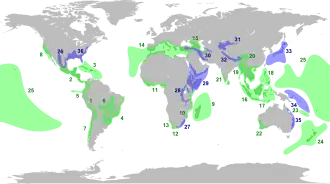biodiversity hotspot
English
WOTD – 22 May 2023
Etymology

A map of the world’s biodiversity hotspots as of July 2010. The regions in green were identified by Norman Myers et al. in their 2000 article in Nature (see the quotation), while those in blue have been identified since then.
From biodiversity + hotspot. The word hotspot to describe such regions appears to have been first used by the British environmentalist Norman Myers (1934–2019) in a 1988 article in The Environmentalist.[1]
Pronunciation
- (Received Pronunciation) IPA(key): /ˌbaɪə(ʊ)daɪˌvɜːsɪti ˈhɒtˌspɒt/
Audio (Southern England) (file) - (General American) IPA(key): /ˌbaɪoʊdəˌvɚsəti ˈhɑtˌspɑt/, [-ɾi]
Audio (US) (file) - Hyphenation: bi‧o‧di‧vers‧i‧ty hot‧spot
Noun
biodiversity hotspot (plural biodiversity hotspots)
- (ecology) A place with a significant level of biodiversity, particularly if the flora and fauna are threatened with loss of their habitat.
- 2000 February 24, Norman Myers, Russell A[lan] Mittermeier, Cristina G[oettsch] Mittermeier, Gustavo A. B. da Fonseca, Jennifer Kent, “Biodiversity Hotspots for Conservation Priorities”, in Nature, volume 403, number 6772, London: Nature Research, , →ISSN, →OCLC, abstract, page 853:
- Conservationists are far from able to assist all species under threat, if only for lack of funding. This places a premium on priorities: how can we support the most species at the least cost? One way is to identify ‘biodiversity hotspots’ where exceptional concentrations of endemic species are undergoing exceptional loss of habitat.
Usage notes
In the writings of Norman Myers and his collaborators, a biodiversity hotspot is defined as a region that contains at least 1,500 endemic species of vascular plants (more than 0.5% of the world’s total), and which has lost at least 70% of its primary vegetation.[2]
Translations
place with a significant level of biodiversity
|
References
- Norman Myers (1988 September) “Threatened Biotas: ‘Hot Spots’ in Tropical Forests”, in The Environmentalist, volume 8, number 3, Dordrecht: Springer Science+Business Media, , →ISSN, →OCLC, page 187, column 2:
- This paper proposes that we can identify a number of localities in tropical forests that; a) feature exceptional concentrations of species with exceptional levels of endemism, and that, b) face exceptional degrees of threat. These “hotspot” areas, 10 of which are identified in this paper, total only 292 000 km² (3.5 percent) of a biome of 8.5 million km² of primary forest remaining.
- Norman Myers, Russell A[lan] Mittermeier, Cristina G[oettsch] Mittermeier, Gustavo A. B. da Fonseca, Jennifer Kent (2000) “Biodiversity Hotspots for Conservation Priorities”, in Nature, volume 403, number 6772, London: Nature Research, , →ISSN, →OCLC, pages 853–858.
Further reading
 biodiversity hotspot on Wikipedia.Wikipedia
biodiversity hotspot on Wikipedia.Wikipedia - “biodiversity hotspot” under “hot spot, n.”, in OED Online
 , Oxford, Oxfordshire: Oxford University Press, December 2022.
, Oxford, Oxfordshire: Oxford University Press, December 2022.
This article is issued from Wiktionary. The text is licensed under Creative Commons - Attribution - Sharealike. Additional terms may apply for the media files.